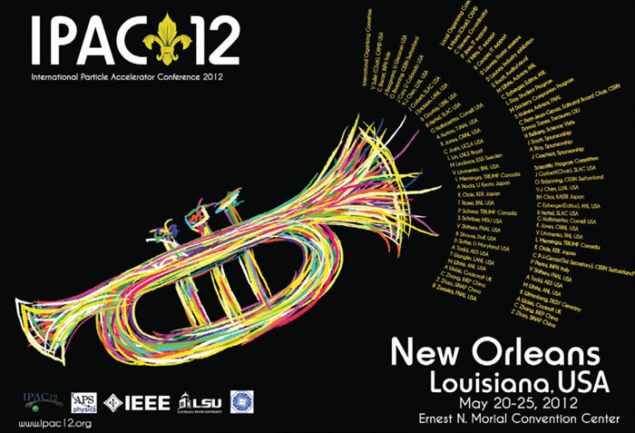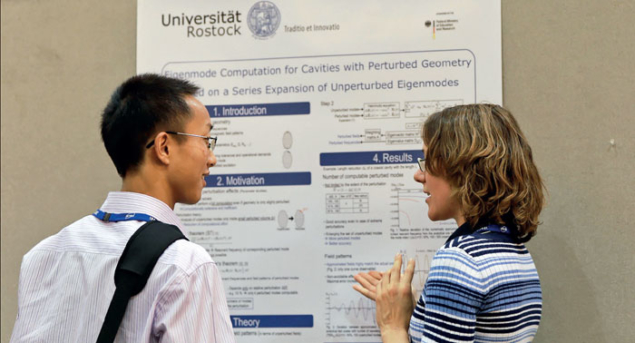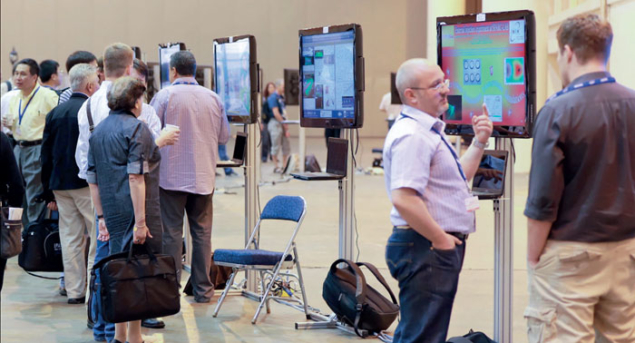A report from IPAC’12 held in New Orleans.

Three years ago, the annual International Particle Accelerator Conference (IPAC) series was launched to reflect the increasingly global effort in the field, with Asia, Europe and North America hosting the meeting on a three-yearly basis. Following meetings in Kyoto (2010) and San Sebastián (2011), it was North America’s turn in 2012. IPAC’12 took place on 20–25 May at the Ernest N Morial Convention Center in New Orleans. True to its international mission, the conference attracted more than 1200 delegates from a diverse cross-section of nationalities, laboratories and areas of expertise. The scientific programme included plenary talks as well as invited and contributed oral presentations, with a healthy balance of speakers representing scientific research efforts from all three global IPAC regions.
Key themes
The conference opening reflected well this international balance and several of the key themes. It began with synchrotron light sources and free-electron lasers (FELs), as Joachim Stohr of the Stanford Radiation Light Source at SLAC highlighted the scientific revolution that is being enabled by X-Ray FELs. CERN’s Steve Myers described the first two years of operation at the LHC – a leading example of high-energy circular colliders, as well as of international collaboration. Accelerator-driven systems for the transmutation of nuclear waste provided one of the latest examples of developing accelerator applications, presented by Dirk Vandeplasche of SCK-CEN. Kenji Saito of KEK put the spotlight on accelerator technology, with a look at future prospects for RF superconductivity. To finish, the opening session moved back to North America and the theme of beam dynamics and electromagnetic fields as Sergei Nagaitsev described the novel concept of the Integrable Optics Test Accelerator that is under development at Fermilab using strong nonlinear magnetic focusing fields.
Proceeding from this synoptic overview, the programme divided into parallel invited oral sessions before the lunch break and contributed oral presentations after lunch. In each case the topical sessions and the topics of the individual speakers had been carefully arranged to avoid overlap of scientific content and/or other interests of the conference delegates. The layout at the New Orleans Convention Center afforded generous space for people to intermingle and easy access between the main hall and parallel sessions.
From Monday to Thursday, each afternoon also featured poster sessions arranged by topic in groups named after famous streets of central New Orleans. About 1250 posters were presented in all. A novel electronic poster session was appropriately held on “Bourbon Street” each afternoon. This session consisted of selected posters featuring colourful animated presentations showing complex machine designs, dynamical beam measurements and the results of 3D simulations, with 54 electronic posters in all. The posters were displayed on large flat screens with local PC connection.
A highly successful exhibit featuring 85 separate vendors was also arranged in the centre of the poster sessions, with ample seating arrangements for conversations between participants. The exhibitors generously sponsored a reception on Tuesday for all of the conference delegates and companions, including complimentary drinks and a buffet of Louisiana-style finger foods.

The programme on Wednesday afternoon contained a special session for industry, covering a range of forward-looking topics. These included projections for future accelerator projects in Asia presented by Zhentang Zhao of the Shanghai Institute of Applied Physics, a look at future medical accelerators by Kiyoshi Yasuoka from the University of Tsukuba and a review of present and future prospects for laser plasma acceleration by Wim Leemans of Lawrence Berkeley National Laboratory. These talks were followed by a review of accelerator-enabled materials development by Wendy Flavell of the University of Manchester, an overview of secondary-beam production by Jens Stadlmann of GSI and the benefits of accelerator R&D to society by Norbert Holtkamp of SLAC.
The IEEE-sponsored event for “Women in Engineering and Science” also took place on Wednesday after the poster sessions. This featured talks covering the demographics of women pursuing careers in engineering and science, personal experiences, objective evaluations and historical perspectives. The talks were delivered by Lia Merminga of TRIUMF, Mei Bei of Brookhaven National Laboratory (BNL), Tracy Morris of Louisiana State University (LSU) and Lorraine Day representing the Center for Advanced Microstructures and Devices (CAMD) at LSU. A buffet reception was held for approximately 50 participants among a display of posters depicting the lives and achievements of outstanding female engineers and scientists.
Thursday afternoon featured the annual awards session and an invited presentation on the LIGO Laser Interferometer Gravity-wave Interferometer by Rainer Weiss of Massachusetts Institute of Technology. Hasan Padamsee from Cornell and Vasili Yakimenko from BNL received the prestigious Particle Accelerator Science Award of the Institute of Electrical and Electronics Engineers/Nuclear and Plasma Science Society (IEEE-NPSS). Erdong Wang from BNL received the IEEE/NPSS student thesis award for studies of secondary emission and the thesis award of the American Physical Society Division of Physics of Beams (APS/DPB) went to Daniel Ratner from SLAC for work on beam dynamics in FELs.

There were also prizes for student posters, exhibited at the Student Poster Session during the conference reception on Sunday. A total of 86 students from around the world received financial support to attend the conference, from the Asian Committee for Future Accelerators, the European Physical Society Accelerator Group and the APS/IEEE. The exhibition attracted an impressive 129 entries, the prizes going to Chen Xu at the Thomas Jefferson National Accelerator Facility (TJNAF) for work on the surface characterization of superconducting radio-frequency cavities and to Theodoros Argyropoulos at CERN for studies of longitudinal single-bunch instability thresholds in the Super Proton Synchrotron.
Parallel satellite meetings were held during the conference for the team behind the Joint Accelerator Conference Website (JACoW), the Joint Universities Accelerator School Advisory Board and the Fixed-Field Alternating Gradient collaboration. The online open-access journal Physical Review Special Topics – Accelerators and Beams (PRST-AB) hosted a “Meet the editors” evening during the conference and held its annual Editorial Board meeting. During the meeting, CERN’s Christine Petit-Jean-Genaz received the first PRST-AB Robert H Siemann Prize, a prize introduced to honour and recognize contributions to the scientific publishing process. A teacher’s day sponsored by the APS took place on the Tuesday. Local high-school science teachers heard from conference speakers during the event, which also included physics demonstrations on topics of current interest in particle accelerators.
The chair’s cocktail reception hosted by conference chair Vic Suller was held in the Mardi Gras World exhibition centre adjacent to the Morial Convention Center. Approximately 250 attended, comprising members of the international Organizing Committee, the Scientific Program Committee and the Local Organizing Committee, as well as support staff, session chairs and invited speakers. The conference banquet took place at the convention centre in the spacious La Nouvelle Orléans ballroom, the evening concluding with enthusiastic dancing to live music by a traditional-style jazz band.
After an invigorating week of accelerator science and engineering, the conference closing session featured plenary talks on the future of X-Ray FELs by Hans Braun from PSI, a review of proton accelerators at the intensity frontier by Paul Derwent from Fermilab and a much anticipated presentation on physics at the LHC – including implications for future high-energy physics programmes – by CERN’s director-general, Rolf Heuer, which foreshadowed the announcement later in the summer of the discovery of a Higgs-like boson at the LHC.
IPAC’12 was closed by the traditional hand-over of the IPAC gavel to the IPAC’13 conference chair, Zhentang Zhao, and the IPAC bell to the chair of the IPAC’13 Science Program Committee, Chuang Zhang. IPAC’13 will take place in Shanghai, with IPAC’14 to follow in Dresden and IPAC’15 in Newport News, Virginia, completing the second three-year cycle through Asia, Europe and North America.
An opportunity to tour the LIGO
On the Saturday after the closing day, participants had the opportunity to tour the laboratory of the Laser Interferometer Gravitational-wave Observatory (LIGO) in Livingston, north of New Orleans – one of the project’s two sites (the other being in Hanford, Washington). Building on Thursday’s guest seminar by Weiss, one of the project’s co-founders, the LIGO staff provided excellent guided tours of the control room, interaction region and a rare opportunity to enter experimental areas that would normally be closed off because of concerns about vibration.
No conference review would be complete without acknowledgment of those who worked for years in advance on the preparations. IPAC’12 was sponsored by the IEEE-NPSS and by the APS-DPB. It was hosted by LSU through its synchrotron-light facility, CAMD, located in Baton Rouge, Louisiana. Particular recognition goes to the small team of CAMD staff who worked diligently behind the scenes to provide local arrangements that spanned the full spectrum of conference needs.
Christine Petit-Jean-Genaz of CERN ran the Scientific Secretariat throughout the organization of the scientific programme, sharing the load with Cathy Eyberger from Argonne National Laboratory and Todd Satogata from TJNAF during the conference. Under their guidance the complete IPAC’12 editorial team, comprising 27 individuals from accelerator laboratories around the world, contributed more than 200 days of work to produce the IPAC’12 conference proceedings, which went online at the JACoW site on 23 July. The IPAC’12 organizers are indebted to the support of the international JACoW team, including its chair Volker Schaa from GSI and deputy Ivan Andrian from Elettra-Sincrotrone Trieste.








